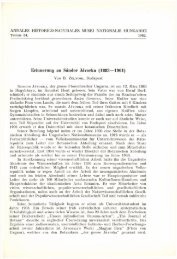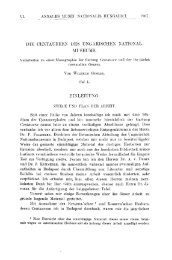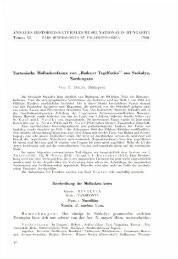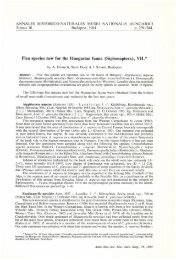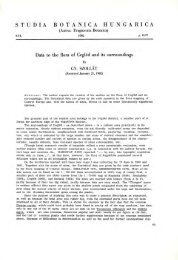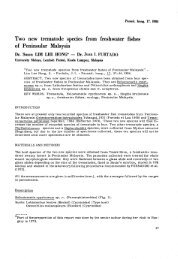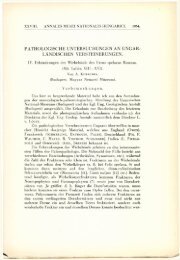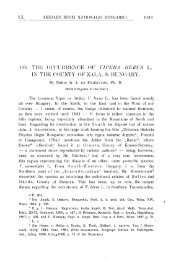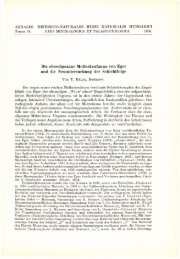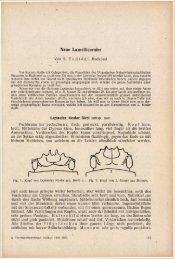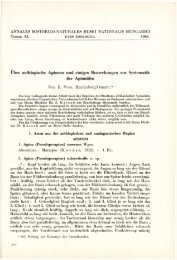New and little-known species of Carabidae from the Middle East and ...
New and little-known species of Carabidae from the Middle East and ...
New and little-known species of Carabidae from the Middle East and ...
You also want an ePaper? Increase the reach of your titles
YUMPU automatically turns print PDFs into web optimized ePapers that Google loves.
52 E. Kirschenh<strong>of</strong>er<br />
9 Elytra predominantly yellowish (black spots much reduced); black<br />
elytral spot reaching interval 5 shortly behind middle; interval 8<br />
slightly darkened just premedially<br />
Taridius (Perseus) pahangensis (KIRSCHENHOFER, 2003)<br />
– Elytra with more extensive black spots 10<br />
10 Internal black spot extending behind anterior margin to interval 5, reduced<br />
before middle, <strong>the</strong>n broadening <strong>and</strong> meeting black interval 8<br />
over a broad area; elytral sides widening posteriorly in a more even<br />
arch Taridius (Perseus) vietnamensis (KIRSCHENHOFER, 1996)<br />
– Internal black spot reduced medially, <strong>the</strong>n widened <strong>and</strong> subsequently<br />
narrowly connected with intervals 6 <strong>and</strong> 7 to black interval 8; elytral<br />
sides widening posteriorly in an almost straight line, only more<br />
rounded in apical third Taridius (Perseus) <strong>and</strong>rewesi EMDEN, 1937<br />
On <strong>the</strong> unicoloured black <strong>species</strong> <strong>of</strong> Brachinus WEBER, 1801<br />
The numerous <strong>species</strong> <strong>of</strong> <strong>the</strong> genus Brachinus WEBER are represented<br />
in all faunistic regions except <strong>the</strong> Australian continent. Most <strong>species</strong> have<br />
colourful dorsum, with sometimes reddish or yellowish spots on <strong>the</strong> elytra<br />
(subgenus Cnecostolus REITTER, 1919); <strong>the</strong> head is <strong>of</strong>ten reddish or yellowish.<br />
Unicoloured black <strong>species</strong> are rare <strong>and</strong> poorly <strong>known</strong>. KIRSCHENHOFER<br />
(2003) described three black <strong>species</strong> <strong>from</strong> Sou<strong>the</strong>ast Asia <strong>and</strong> placed <strong>the</strong>m<br />
in <strong>the</strong> Brachinus orestes <strong>species</strong> group based on <strong>the</strong>ir smooth apical elytral<br />
margin. An additional <strong>species</strong> <strong>of</strong> this group is described here <strong>from</strong> <strong>the</strong><br />
Sunda Isl<strong>and</strong>s (Lombok), a region poorly investigated entomologically.<br />
Two additional black <strong>species</strong> were described <strong>from</strong> <strong>the</strong> Philippines by TIAN<br />
&DEUVE (2007), but without subgeneric assignment. The poorly <strong>known</strong><br />
Philippine <strong>species</strong> B. luzoicus CHAUDOIR, 1876 <strong>and</strong> B. piceus CHAUDOIR,<br />
1876 were redescribed in that publication, establishing that <strong>the</strong> latter <strong>species</strong><br />
has bluish elytra <strong>and</strong> a reddish head <strong>and</strong> pronotum. All o<strong>the</strong>r <strong>species</strong><br />
mentioned in that revision are uniformly black, <strong>and</strong> are included in <strong>the</strong> list<br />
below.<br />
Annls hist.-nat. Mus. natn. hung. 102, 2010



